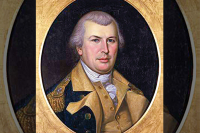Stuck in a stinky situation
Hopefully, any encounter you have with a skunk will be a sighting, not a spraying. Neither my wife nor I have ever been sprayed by a polecat. But our dogs have — and they were pitiful creatures for days afterward.
Five skunk species are resident in the United States: hooded skunks, hog-nosed skunks, western spotted skunks, eastern spotted skunks, and striped skunks. Only the last two reside in the Blue Ridge Province. The striped skunk — which is black with two white stripes running up its back to form a cap on top of its head — is the one that usually comes to mind when someone starts telling skunk tales. In certain areas, however, the spotted skunk is the more common species. Sometimes referred to as a civet, the spotted skunk is black with a white spot on its forehead and under each ear. There are also four broken white stripes along its neck, back, and sides, as well as a white-tipped tail.
The spotted skunk averages 17 inches in length and three pounds in weight, while the larger striped skunk averages 25 inches and nine pounds. Both species locate dens in rock outcrops, old woodchuck burrows, and other readily available locations, including spaces in the foundations of human dwellings. In addition to eating fruit, they both prey on a variety of insects, grubs, and small mammals.
Now we get to the interesting part. The rear end is, of course, the business end of a polecat. That’s where the two vented anal glands are located that contain the potent, odoriferous fluid that can be sprayed with accuracy for distances of up to twelve or so feet. The mist from this fluid will often carry another thirty feet, while the nauseating odor will permeate the surrounding countryside for up to a mile. If need be, there is enough fluid in the anal glands to provide a skunk with up to six rounds of ammunition. Under normal circumstances, however, one blast is quite sufficient; indeed, most predators are so wary once they spot a skunk’s distinctive black-and-white markings that it can usually saunter through the woodlands without being disturbed.
When provoked, a striped skunk raises its tail daintily like a plume and assumes a U-shaped posture that allows its hip muscles to squeeze the fluid out of the anal glands. The spotted skunk has perfected added embellishments to that basic strategy, as described by Donald W. Linzey in Mammals of Great Smoky Mountains National Park (1995):
When frightened or angered, the eastern spotted skunk may engage in several unique behaviors that may serve as either a bluff or a warning prior to the discharge of the scent. It may stamp or pat its front feet in rapid succession on the floor or ground. It can also do a ‘handstand’ on it front feet. The skunk upends itself, holds its tail in the air, and may walk up to several yards in this manner.
Related Items
In Mammals of the Carolinas, Virginia and Maryland (1985), David William Webster and the other authors of that volume, added the observation in regard to this handstand posture that “it allows the skunk to see where it aims its spray.”
The ancient Cherokees knew both the striped and spotted skunk as dila. Arlene Fradkin noted in Cherokee Folk Zoology: The Animal World of a Native American People, 1700–1838 (1990) that they believed its potent odor served as a counterbalance to contagious diseases. Scent glands were removed from carcasses, pierced with a small hole, and hung over doorways. After the Civil War, one of the Cherokees who had served with the Union brought back smallpox to the Indian Reservation from an infected camp near Knoxville. When he died shortly thereafter, his funeral was widely attended by the Cherokees. The disease spread like wildfire within a week. Entire skunk bodies were hung up in the vain hope they would somehow ward off the pestilence. Oil from the anal glands was rubbed directly upon infected people. Tribal members finally resorted to cooking and eating skunk meat.
Various old-time, skunk-odor removal techniques are reported in skunk literature. But time is probably the only real cure if you get sprayed. Wash out your eyes with water and burn or bury your clothes. Try not to think about what happened. Don’t go out in public for a while.
George Ellison wrote the biographical introductions for the reissues of two Appalachian classics: Horace Kephart’s Our Southern Highlanders and James Mooney’s History, Myths, and Sacred Formulas of the Cherokees. In June 2005, a selection of his Back Then columns was published by The History Press in Charleston as Mountain Passages: Natural and Cultural History of Western North Carolina and the Great Smoky Mountains. Readers can contact him at P.O. Box 1262, Bryson City, N.C., 28713, or at This email address is being protected from spambots. You need JavaScript enabled to view it..









